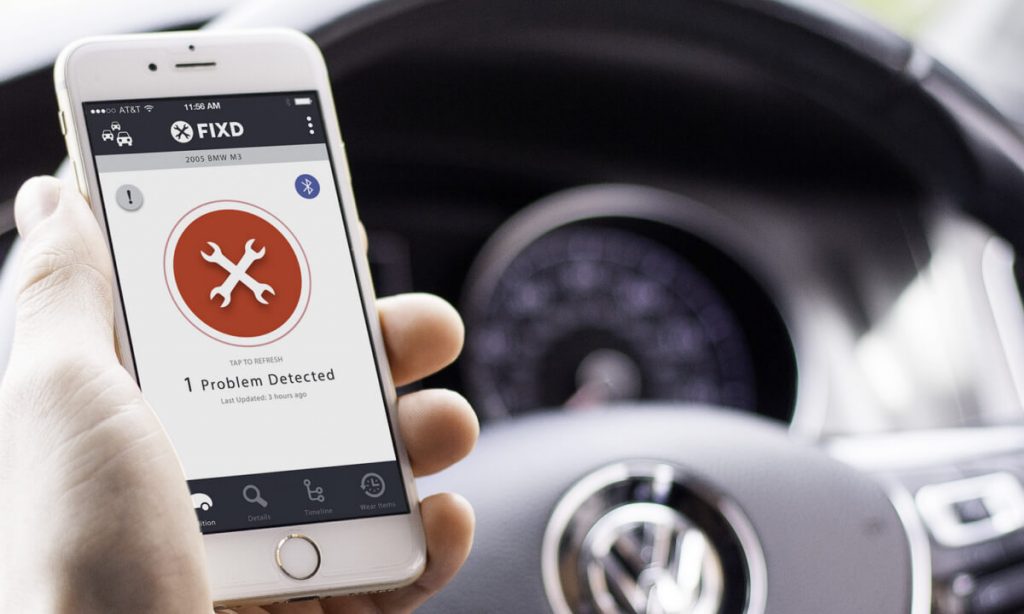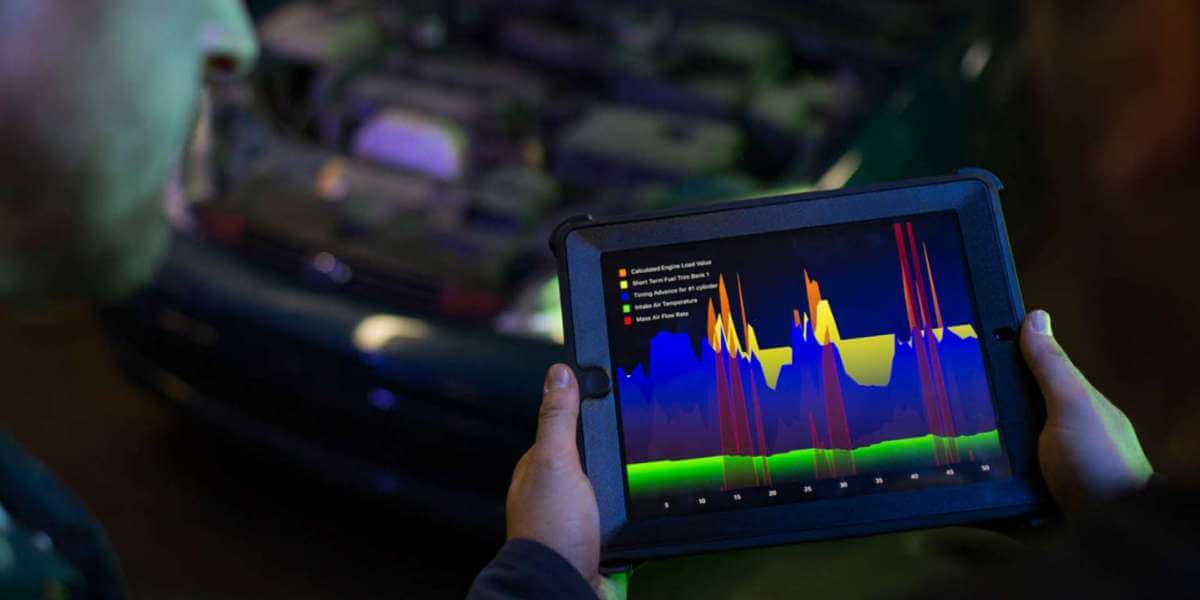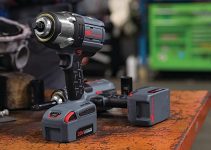
- Device dimensions: 4.4” X 3” X 1.2”
- Compatible with US vehicles after 1996, EU vehicles after 2002, and Asian vehicles after 2005
- Live data stream and freeze frame functionality
- Can read and clear fault codes
- Works with Android and iOS devices
- No additional service subscription costs

- Device dimensions: 2.2” X 1.9” X 1”
- Live data stream functionality with customizable view
- All vehicle module access
- Compatible with iOS and Android devices
- No extra subscription costs

- Device dimensions: 1.5” X 0.5” X 1.75”
- Compatible with all gas-powered vehicles manufactured after 1996
- Live data stream functionality
- Free version allows you to read and clear codes
- Compatible with iOS and Android devices
- Optional subscription pack costs extra
With modern cars slowly turning into computers on wheels, reading DTC codes and analyzing live engine data is essential for most serious troubleshooting tasks. And for that, you’ll need an OBD2 scan tool. Unfortunately, professional scan tools are often quite expensive and usually come equipped with extensive features that you don’t really need if you only want to know why your check engine light just popped up in your dashboard.
Luckily, Bluetooth OBD2 scanners are usually much cheaper and frequently offer more than enough features for most people. However, with the high number of models out there, it’s easy to get a bit lost and end up buying a cheap Chinese knock-off that will only leave you disappointed.
To help you find the right one and save some money on car repair bills, we’ve come up with a list of the best Bluetooth OBD2 scanner currently on the market. Keep in mind that some of them are better suited for beginners and weekend DIYers, while others, usually the more expensive ones, are only worth it if you work in the field.
In all cases, make sure to evaluate your budget and needs before you start shopping around. After all, the only thing worse than buying a tool that doesn’t do what you expect him to is paying too much for something you will never use anyway.
Table of Contents
Why Do You Need a Bluetooth OBD2 Scanner?
All modern cars have various onboard computers monitoring a wide range of parameters and ensuring optimum performance and safety at all times. If some of these parameters go out of a specific threshold, the system warns the driver with the appropriate warning light.
When that happens, a specific code that can help pinpoint the problem will be stored in the vehicle’s memory. On-Board Diagnosis, or OBD in short, is a unified protocol that stores these codes in a specific format. As a result, every code will have the same meaning in any car, regardless of make or model.
However, access to these codes is only possible using a special device called an OBD2 scan tool that connects to the vehicle through a dedicated port. Dealers and professional workshops use various diagnostic tools for this purpose, but these tend to be quite expensive. Still, Bluetooth OBD2 scanners are much more affordable options, making them suitable for non-professionals.
Bluetooth OBD2 Scanner Reviews
1. BlueDriver Bluetooth Pro OBDII Scan Tool for iPhone & Android — Premium Pick
[amazon fields=”B00652G4TS” value=”thumb” image_size=”large” image_alt=”BlueDriver Bluetooth Pro OBDII Scan Tool for iPhone & Android”]
With a wide range of features, the BlueDriver Pro is probably the most powerful Bluetooth scan tool on the market today. The package includes a sleek OBD2 adapter and a corresponding application that works both on Androids and iPhones—a combo ensuring quality and reliable operation.
One of the major features setting it apart from the competition is its advanced code reading capability. As a result, it will give access to all vehicle modules, including anti-lock brakes and airbag systems. Troubleshooting is easy, thanks to advanced onboard tests, smog checks, and an option to capture freeze frames. Another interesting feature is the “repair reports” function, which estimates possible causes for each error code.
All things considered, BlueDriver Pro is a unique OBD2 scanner offering the most comprehensive access. It will be the perfect tool for troubleshooting modern cars with complex systems and elaborate vehicle infrastructure. Despite having a bit higher price, it will prove its value to users looking for something extra. In fact, it’s so good that it’s even suitable for full-fledge auto mechanics.
Highlighted features
- Device dimensions: 2.2” X 1.9” X 1”
- Live data stream functionality with customizable view
- All vehicle module access
- Compatible with iOS and Android devices
- No extra subscription costs
Pros:
- Gives access to most vehicle modules
- Advanced tests and live data with freeze frame option
- Repair reports with estimates of possible causes for each error code
- Smog check that evaluates vehicles readiness for an emissions test
Cons:
- More expensive than its competitors (but worth every penny!)
2. FIXD OBD2 Professional Bluetooth Scan Tool & Code Reader — Budget Pick
[amazon fields=”B013RIQMEO” value=”thumb” image_size=”large” image_alt=”FIXD OBD2 Professional Bluetooth Scan Tool & Code Reader”]
Among all devices on the market, the FIXD Bluetooth scanner is the one that comes with the most user-friendly application. Besides being easy to use, it also gives a helpful explanation in plain English for more than 7000 error codes. An additional feature is the option to give notifications on upcoming mileage-specific maintenance schedules based on vehicle make.
And if you need more access than the more basic modules, upgrading to a Premium package will transform this scan tool into a truly powerful platform, quite similar to other professional hand-held models.
One of the most interesting features of the FIXD Bluetooth scanner is the Mechanic Hotline allowing users to call a professional technician for valuable advice. It ranges from second opinions to questions about what parts to buy or DIY repair walkthroughs. The premium package also gives access to confirmed fixes and corresponding repair costs, which protect users from getting ripped off. And even better, the “Issue Forecast & Commonality” feature helps predict future problems based on data from other users with similar vehicles.
If you are a beginner or simply wrench on the side and need a little more help troubleshooting problems, the FIXD Bluetooth scanner is the one you need.
Highlighted features
- Device dimensions: 1.5” X 0.5” X 1.75”
- Compatible with all gas-powered vehicles manufactured after 1996
- Live data stream functionality
- Free version allows you to read and clear codes
- Compatible with iOS and Android devices
- Optional subscription pack costs extra
Pros:
- User-friendly application with easy to understand explanations for most error codes
- Gives notifications on upcoming maintenance schedules
- Premium package offering access to Mechanic Hotline, Confirmed Fixes & Cost, and Issue Forecast
Cons:
- Access is limited to engine and transmission modules
- Premium package cost extra
3. ANCEL BD200 Wireless OBD2 Code Reader — Editor’s Pick
[amazon fields=”B08DFYMTS6″ value=”thumb” image_size=”large” image_alt=”ANCEL BD200 Wireless OBD2 Code Reader”]
Ancel BD200 OBD2 scanner offers the widest vehicle coverage, making it perfect for anyone planning to work on multiple makes and models. Indeed, it supports all diagnostic protocols that modern cars use, which is not common among competing devices. Like most of them, it comes with a corresponding application that works both on Android and iPhone. It has a simple and intuitive interface that is also highly customizable, allowing users to customize and monitor different sets of data parameters depending on the problem at hand.
Another upside of this device is monitoring voltage values, which allows for a simple battery check. You can leave it plugged in and monitor your engine data in real-time as you drive.
Interestingly, there is also a trip analysis function that features voice alarms in cases of speeding and fatigue.
Highlighted features
- Device dimensions: 4.4” X 3” X 1.2”
- Compatible with US vehicles after 1996, EU vehicles after 2002, and Asian vehicles after 2005
- Live data stream and freeze frame functionality
- Can read and clear fault codes
- Works with Android and iOS devices
- No additional service subscription costs
Pros:
- Supports all diagnostic protocols, enabling the widest vehicle coverage
- Comes with a user-friendly and highly customizable smartphone application
- I/M readiness shows the status of all monitoring systems
- Performs a battery check by monitoring voltage values
- Doubles as a trip assistant
Cons:
- The adapter is a bit bulky, which can be a drawback in some situations
- Can only access engine and transmission modules and codes
4. Autel AP200M OBD2 Scanner Bluetooth OE-Level All-System Diagnoses
[amazon fields=”B08GB82MFG” value=”thumb” image_size=”large” image_alt=”Autel AP200M OBD2 Scanner Bluetooth OE-Level All-System Diagnoses”]
The Autel AP200M is another Bluetooth OBD2 scanner that offers unmatched versatility and comprehensive vehicle coverage. It is compatible with nearly all US cars built since 1996, European vehicles since 2000, and Asian vehicles since 2008.
Autel’s scanner offers six primary maintenance functions: oil reset, SRS, battery management system, electric parking brake, DPF, and throttle match. These functions are among the widely used ones, and the quick access feature can come in handy. Of course, you also get the ability to run a complete systems diagnosis to make sure things are running smoothly.
The AP200M OBD2 scanner comes with one year of free manufacturer software access with unlimited updates. You can choose to extend the service beyond the expiration date by paying a small fee of $19.99 per year. Furthermore, purchasing the manufacturer’s software will allow you to do more than just basic OBD2 functions like reading and clear codes.
Autel offers a highly versatile Bluetooth OBD2 scanner suitable for continuous and faultless use by professional mechanics. However, if you decide to go for it, be prepared to purchase the optional manufacturer software as you can’t do much without it, aside from reading codes, of course.
Highlighted features
- Device dimensions: 7.4” X 4” X 1.4”
- Compatible with iOS and Android devices
- Performs all OBD2 functions
- Uses a dedicated mobile application
- $19.99 subscription fee after one year
- 32.8 ft Bluetooth range
Pros
- Up to 3 times more accurate than other Bluetooth OBD2 scanners
- Comes with one year of free manufacturer software access
- Advanced technology with auto-pairing
- 13 different user-selectable languages
- Easy access to 6 common maintenance functions
- Dedicated app with Android and iOS capability
- Full systems diagnosis functionality
- Reasonably priced
- 1 year limited manufacturer warranty
Cons
- Takes considerably longer to run a scan
- Extra cost for useful features
5. INNOVA OBD2 Scanner Bluetooth Diagnostic Code Reader 6000P
The Innova brand stands at the forefront of technology and is known for consistently developing pretty decent products that won’t break the bank. The 6000P OBD2 Bluetooth scanner is a comprehensive model capable of reading and clearing trouble codes related to specific issues, including ABS, Airbags, and even tire pressure monitoring systems.
When connected via a mobile application to your iOS or Android device, the Innova 6000P will also display a live data stream allowing you to monitor your car’s vital parameters in real-time. You can also store and export the data for further diagnosis.
When it detects a problem with your car, the 6000P scanner will show the error code and present you with possible fixes, saving you an expensive trip to the mechanic and helping you learn how to fix your car on your own.
Innova’s 6000P OBD2 Bluetooth scanner will prove to be an invaluable addition to any amateur and professional mechanic’s tool arsenal. Its additional features like the ability to conduct a smog test, print data reports, easy setup, and live data monitoring are what make it one of the best Bluetooth OBD2 scanners in the market.
Highlighted features
- Device dimensions: 7.7” X 3.5” X 2.25”
- Compatible with iOS and Android devices
- Performs all OBD2 functions
- Uses two dedicated mobile applications available on Google Play and Apple App store
- No additional subscription required
- TPMS, emissions, and smog check functionality
Pros
- Provides easy and quick solutions to problems
- Live data stream functionality
- Record, store, and print vital data using a mobile application
- No hidden costs or fees for lifetime
- Comes with technical assistance from ASE certified technicians
- Ability to perform a full system check with ABS< check engine light, SRS, and much more
- Perfect tool for expert mechanics due to its versatility
Cons
- Costs more than other models
Frequestly Asked Questions (FAQ)
What is OBD2?
OBD stands for onboard diagnosis, which is a common language that makes the communication almost identical on all cars. Despite their differences, all modern cars have an electronic infrastructure that operates on similar principles. On one side, there is a range of sensors that measure an incredibly wide range of data.
The onboard computer uses these values to determine how different systems are running and decide on appropriate actions. If any of these values are out of the predetermined range, the system will store a specific 4-digit error code within its memory, making it easier for mechanics to identify the culprit and fix it.
Which cars use OBD2?
The usage of the OBD2 standard began in 1996 to improve fuel economy and reduce emissions but also to make fixing cars that were becoming increasingly complicated a lot easier. Still, there are variations between makes and models, as manufacturers implemented this technology at different times. This is why there is no simple and definitive answer to which cars use OBD standards. However, gasoline cars made after 1996 and those with diesel engines made after 2000 are all OBD2-compliant.
What can Bluetooth OBD2 scanners do?
Despite their simplicity and affordable price, Bluetooth OBD2 scanners are a reliable way of getting an insight into vehicles’ running parameters. Although there are different models available on the market, all of them work on the same principle. Connecting them to the vehicle will give users access to stored error codes and live data. While basic models are limited to drivetrain modules and their parameters, more advanced ones can also communicate with other systems.

Where do these scanners connect to?
All modern cars have something called an OBD2 port, a standard socket for connecting a diagnostic tool. In most cases, this port will be easy to find somewhere under the dash, usually on the left side, sometimes on the right, sometimes near the fuse box—it depends. However, some manufacturers choose a different location, which can make things a bit more difficult. The OBD2 port may be hiding in places like the glove box or behind the ashtray in those vehicles. That being said, if your car was produced after 1996, there’s one somewhere.
If you can’t find it, consulting the user manual or performing a quick Google search should reveal the exact location in a jiffy.
What is the difference between scanners and diagnostic tools?
Most modern OBD2 scanners are capable devices that can do more than just reading error codes. Still, even the best among them have their limitations. Although being more expensive and complex, diagnostic tools are far more powerful machines. Besides standard functions that are similar to scanners, they can run test procedures and perform various adjustments. But unless you are a professional auto mechanic working 40-hours a week in the shop and do extensive fuel injection tuning, for example, you don’t really need a full-fledged diagnostic tool.
Verdict
As we have shown in this article, there is a wide range of scanners with different features available on the market. Capable devices like the BlueDriver Bluetooth Scan Tool will access all vehicle systems and stored codes. Although other scanners may have specific limitations, they are usually cheaper and can still be more than enough for most users. On the flip side, certain devices like the Autel AP200M will provide original equipment-level features, such as the ability to run a comprehensive all systems scan along with other commonly-used functions.
In all cases, make sure to correctly evaluate your budget and needs first. But as a general rule, if you aren’t so sure which one you should buy, get your hands on the BlueDriver or FIXD models—they won’t disappoint!








![Best Tire Changers for Amateurs and Professionals [2022 Review]](https://garagespot.com/wp-content/uploads/2022/01/Best-tire-changer-e1652905942544-compress-211x150.jpg)
Gentlemen: Alfa Romeo did not have this requirement when it abandoned US market sales after a disastrous 1995. In fact all cars on the following years in the US had to have this requirement. Alfa did not. The new ones do — after 1997.
But I have finally acquired a 1996 model 916 GTV with a V6 (2.0 liter) Turbo from a Cleveland owner who had bought it from a Canadian who had got it from Japan where it was originally sold by Alfa Romeo. This vehicle is very tricky in that it stars on three cylinders and the motor needs to be warmed sufficient before engaging the turbo or the engine floods and will stop. Then it is terribly frustrating to sit in traffic to wait an hour or more to start it. What did the Japanese use in 1996?
Wow! That’s quite the journey! Regarding your diagnostic challenges, it’s important to note that in 1996, the U.S. mandated the OBD2 standard for all passenger vehicles sold, aimed at standardizing the method for retrieving vehicle diagnostics and emissions data. However, since your Alfa is an Italian car originally sold in Japan and imported, it may not be equipped with an OBD2 system, which is likely contributing to the difficulty in diagnosing and addressing the starting issues and engine flooding you’re experiencing.
Even worse, back in 1996, Japanese cars used proprietary diagnostic protocols and connectors specific to each manufacturer. These proprietary systems were precursors to the OBD2 system and varied significantly from one car maker to another, making them less standardized and often requiring specific tools and software to access diagnostic information.
For instance, Nissan used a proprietary diagnostic system known as Consult (and later Consult II and III for newer models), Toyota had its diagnostic terminals, known as TE1 and TE2, Honda used a proprietary interface for diagnostics, known as the PGM Tester, Mitsubishi utilized the MUT-II (Multi-Use Tester II), Subaru used the Select Monitor system, and so on.
But once again, since your Alfa is not technically a Japanese car, it only makes the problem more complicated, and I have to admit that I have no idea whether Alfas of the time sold in Japan used an Italian or Japanese diagnostic protocol.
Unfortunately, that’s probably something you’d need to inquire directly with Alfa Romeo — they are probably the best ones to answer this question.
Sorry to not be of more help.